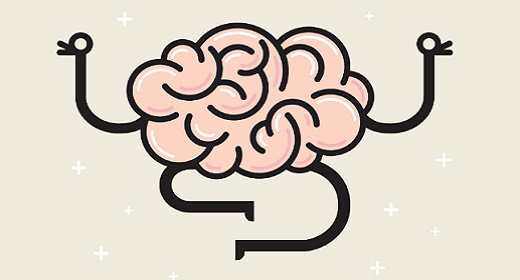by Ellen Hendriksen: Mindfulness is the biggest thing since indoor plumbing…

But as the mindfulness movement rolls on, myths and misinformation have popped up, like sweets in your grocery cart when shopping with a toddler. Therefore, this week Savvy Psychologist Dr. Ellen Hendriksen busts the 5 biggest myths of mindfulness.
Mindfulness is everywhere these days. Mindfulness headlines like “Healthy Mind, Healthy Life” or “The Medicine of the Moment” are trumpeted from grocery store checkout stands, right next to celebrity gossip and thinner thighs.
In many ways, this is a good thing: mindfulnessis improving lives the world over. Recent studies have found mindfulness benefits everyone from emergency room nurses to law students waiting for their bar exam results to pregnant women—to the extent that their babies later showed less negative social-emotional behavior than the babies of less mindful women.
But as the mindfulness movement gets bigger and more unwieldy, misconceptions sprout like mushrooms after the rain. Therefore, this week, we’ll tackle the five biggest myths of mindfulness.
The 5 Myths of Mindfulness
- Mindfulness is meditation.
- Mindfulness is about taking time out to rest and relax.
- Mindfulness is having no thoughts.
- The ultimate goal is to be mindful all the time.
- Mindfulness is bliss.
Let’s explore each in more detail.
Myth #1: Mindfulness is meditation.
The two terms mindfulness and meditation often get thrown around interchangeably.
Mindfulness is an awareness. It’s paying attention, on purpose, in the present moment, without judgment. You don’t need a meditation cushion, or even more than a split second, to be mindful. Dr. Jon Kabat-Zinn, one of the first American mindfulness researchers, likens mindfulness to being behind a waterfall. You’re not under the waterfall, caught in the swirl and pounding of thoughts, emotions, and sensations, nor are you trying to stop or change them. Instead, you’re behind the cascade, observing all that’s happening without evaluation.
Mindfulness meditation, by contrast, is a practice. It’s all the awareness that is mindfulness, but sustained. Rather than just checking in with the waterfall, it’s logging some time behind it. It’s bringing your attention back when it inevitably wanders away, often many times a minute.
Meditation requires sustained attention on an object. And by “object,” I don’t mean a physical object like a toothbrush or a can of green beans—instead, it’s simply something on which to focus your attention. The classic is your breath, but it could also be your body, a piano sonata, or the thoughts running through your head. You can mindfully meditate on the sensations of walking, washing dishes, or eating a cookie. Really, you can be mindful of anything, and likewise, anything can be the object of mindfulness meditation.
Myth #2: Mindfulness is about taking time out to rest and relax.
This is another big one. Mindfulness isn’t relaxation. Stress reduction may be a side effect; checking in with your thoughts, body, and impulses decreases your chance of getting yanked around by them, which in turn lightens your life’s drama quotient considerably. Likewise, the “without judgment” part may result in less stress—we all feel lighter with less judgment.
But fundamentally, mindfulness isn’t rest; indeed, the two are kind of apples and oranges. Even remembering to be mindful can take quite a bit of work. But many people, including me, find that checking in with their thoughts, feelings, and sensations, even if it’s not necessarily restorative, is definitely illuminating.
Myth #3: Mindfulness is having no thoughts.
The idea that mindfulness requires a blank mind is a myth that makes many people believe they can’t be mindful. But just like you can’t stop your heart from beating or your stomach from digesting, you can’t stop your brain from thinking. That’s what it does.
Think about it this way: mindfulness isn’t a suspension of thoughts; instead, it’s a suspension of judgment.
Put another way, mindfulness is an observation of what’s happening: that itch above your left eyebrow, the bad taste in your mouth, the realization that the thought that you’re a bad daughter is nothing more than a thought, or the fact that the Kit Kat jingle has been running through your head for the better part of a minute.
Mindfulness welcomes any and all thoughts, but sees them as just that: thoughts. As my favorite bumper sticker sums up: Don’t believe everything you think.
Myth #4: The ultimate goal is to be mindful all the time.
Not at all. It’s impossible to be in the present moment at all times. Sometimes you need to plan for the future: “What’s for dinner?” or “I can feel a migraine coming on—I should really take some medicine, drink some coffee, and go lie down.” It’s important to reflect on the past: “Next time I’ll actually try to listen rather than shooting off my mouth,” or “Ugh, I shouldn’t have eaten those leftover pork dumplings.”
Even mindfulness gurus have many mindless moments.
Being aware of everything in the present moment all the time isn’t just impossible, it would leave us overstimulated and exhausted. Even mindfulness gurus have many mindless moments—getting lost in rumination, daydreaming, or humming another jingle: how about Folgers this time?
Myth #5: Mindfulness is bliss.
This is a tough one. Mindfulness is not simply savoring the moment, of taking time to notice the hues of a sunset, or the taste of that warm chocolate chip cookie, or the bubbles in your champagne. It’s also noticing your defensiveness after losing your temper, your helplessness in the face of injustice, or that the milk in your coffee has most definitely gone sour.
In short, mindfulness looks at the negative, the neutral, and the positive, all with equanimity. It’s not joy—instead, it’s the awareness of joy, but also of pain and everything else.
It’s taking a step back from the constant input of sensory information and the constant output of thoughts and feelings. Whether for a split second or many hours, it’s your journey behind the waterfall.
And with any luck, you won’t find the Kars for Kids jingle there waiting for you.














































